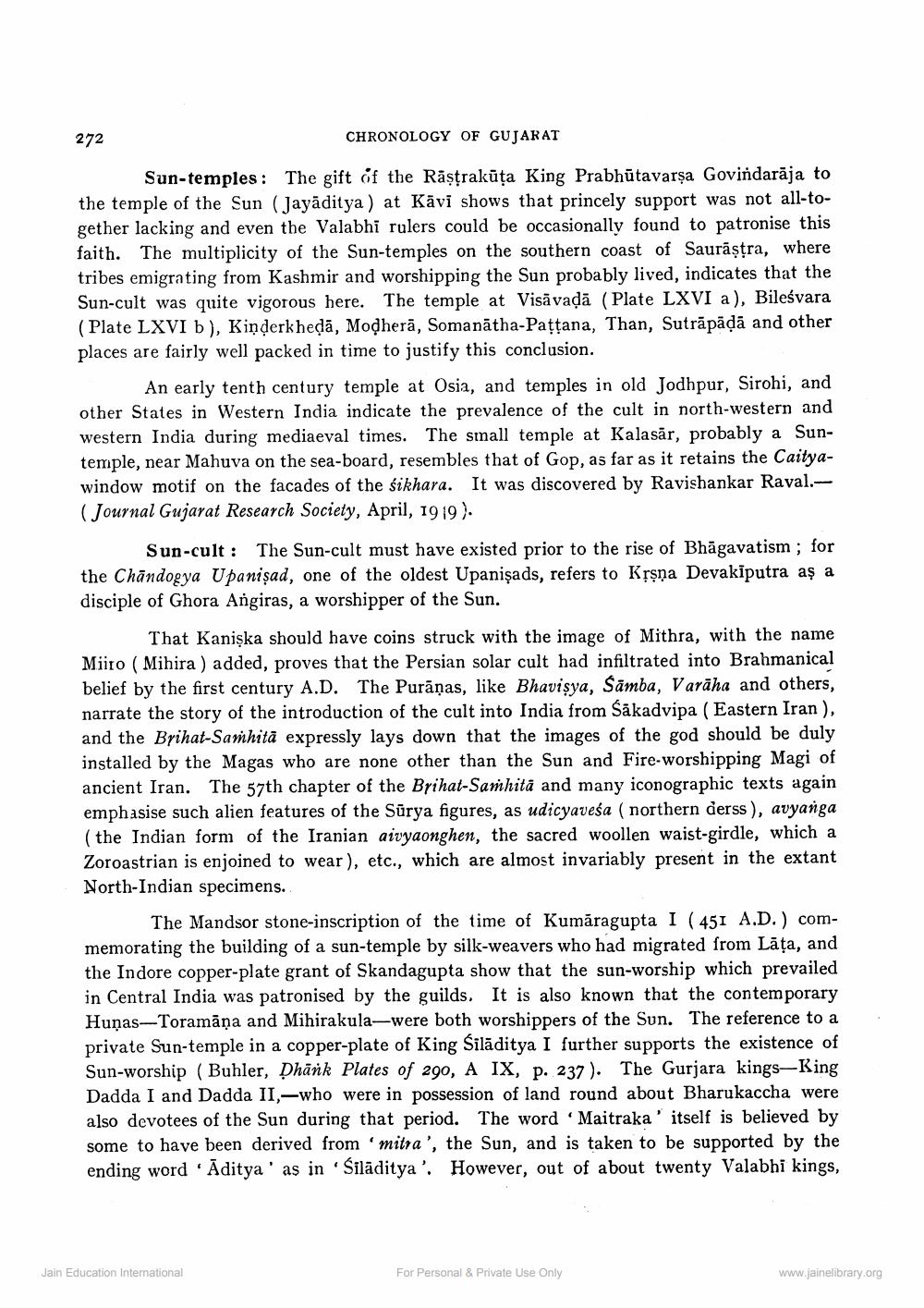________________
CHRONOLOGY OF GUJARAT
Sun-temples: The gift of the Răstrakūta King Prabhütavarṣa Govindaraja to the temple of the Sun (Jayaditya) at Kävi shows that princely support was not all-together lacking and even the Valabhi rulers could be occasionally found to patronise this faith. The multiplicity of the Sun-temples on the southern coast of Saurastra, where tribes emigrating from Kashmir and worshipping the Sun probably lived, indicates that the Sun-cult was quite vigorous here. The temple at Visavada (Plate LXVI a), Bileśvara (Plate LXVI b), Kinderkheda, Modherä, Somanatha-Pattana, Than, Suträpädä and other places are fairly well packed in time to justify this conclusion.
272
An early tenth century temple at Osia, and temples in old Jodhpur, Sirohi, and other States in Western India indicate the prevalence of the cult in north-western and western India during mediaeval times. The small temple at Kalasår, probably a Suntemple, near Mahuva on the sea-board, resembles that of Gop, as far as it retains the Caityawindow motif on the facades of the sikhara. It was discovered by Ravishankar Raval.(Journal Gujarat Research Society, April, 1919).
Sun-cult: The Sun-cult must have existed prior to the rise of Bhagavatism; for the Chandogya Upanisad, one of the oldest Upanisads, refers to Kṛṣṇa Devakiputra as a disciple of Ghora Angiras, a worshipper of the Sun.
That Kanişka should have coins struck with the image of Mithra, with the name Miiro (Mihira) added, proves that the Persian solar cult had infiltrated into Brahmanical belief by the first century A.D. The Puranas, like Bhavisya, Samba, Varaha and others, narrate the story of the introduction of the cult into India from Såkadvipa (Eastern Iran), and the Brihat-Samhita expressly lays down that the images of the god should be duly installed by the Magas who are none other than the Sun and Fire-worshipping Magi of ancient Iran. The 57th chapter of the Brihat-Samhita and many iconographic texts again. emphasise such alien features of the Surya figures, as udicyavesa (northern derss), avyanga (the Indian form of the Iranian airyaonghen, the sacred woollen waist-girdle, which a Zoroastrian is enjoined to wear), etc., which are almost invariably present in the extant North-Indian specimens..
The Mandsor stone-inscription of the time of Kumaragupta I (451 A.D.) commemorating the building of a sun-temple by silk-weavers who had migrated from Lâța, and the Indore copper-plate grant of Skandagupta show that the sun-worship which prevailed in Central India was patronised by the guilds. It is also known that the contemporary Hunas-Toramana and Mihirakula-were both worshippers of the Sun. The reference to a private Sun-temple in a copper-plate of King Siläditya I further supports the existence of Sun-worship (Buhler, Dhänk Plates of 290, A IX, p. 237). The Gurjara kings-King Dadda I and Dadda II,-who were in possession of land round about Bharukaccha were also devotees of the Sun during that period. The word 'Maitraka' itself is believed by some to have been derived from mitra, the Sun, and is taken to be supported by the ending word Aditya' as in 'Siladitya'. However, out of about twenty Valabhi kings,
Jain Education International
For Personal & Private Use Only
www.jainelibrary.org




